In 2018, when I started designing crochet stuff, I made the first Starry Night Blouse. It was my first year doing this.
I feel like my best designs come from back then because I was more into making things and less into writing down how to do it. Writing patterns is tough. Sometimes it’s hard to explain in words how to crochet something. It’s not because it’s too hard to make, but explaining it can be wordy and tricky. Making a crochet or knitting pattern that’s clear and easy to follow is not easy.
Anyway, this year, with the help of the awesome folks at Expression Fiber Arts, I crocheted a new Starry Night Blouse using their beautiful yarn.
I changed a few things in this new one. I used the same stitch pattern all through, and I made the whole blouse in pieces. I added cuffs, a ribbed bottom, and a V neckline for the front.
Modelul In Limba Romana, il puteti gasi aici
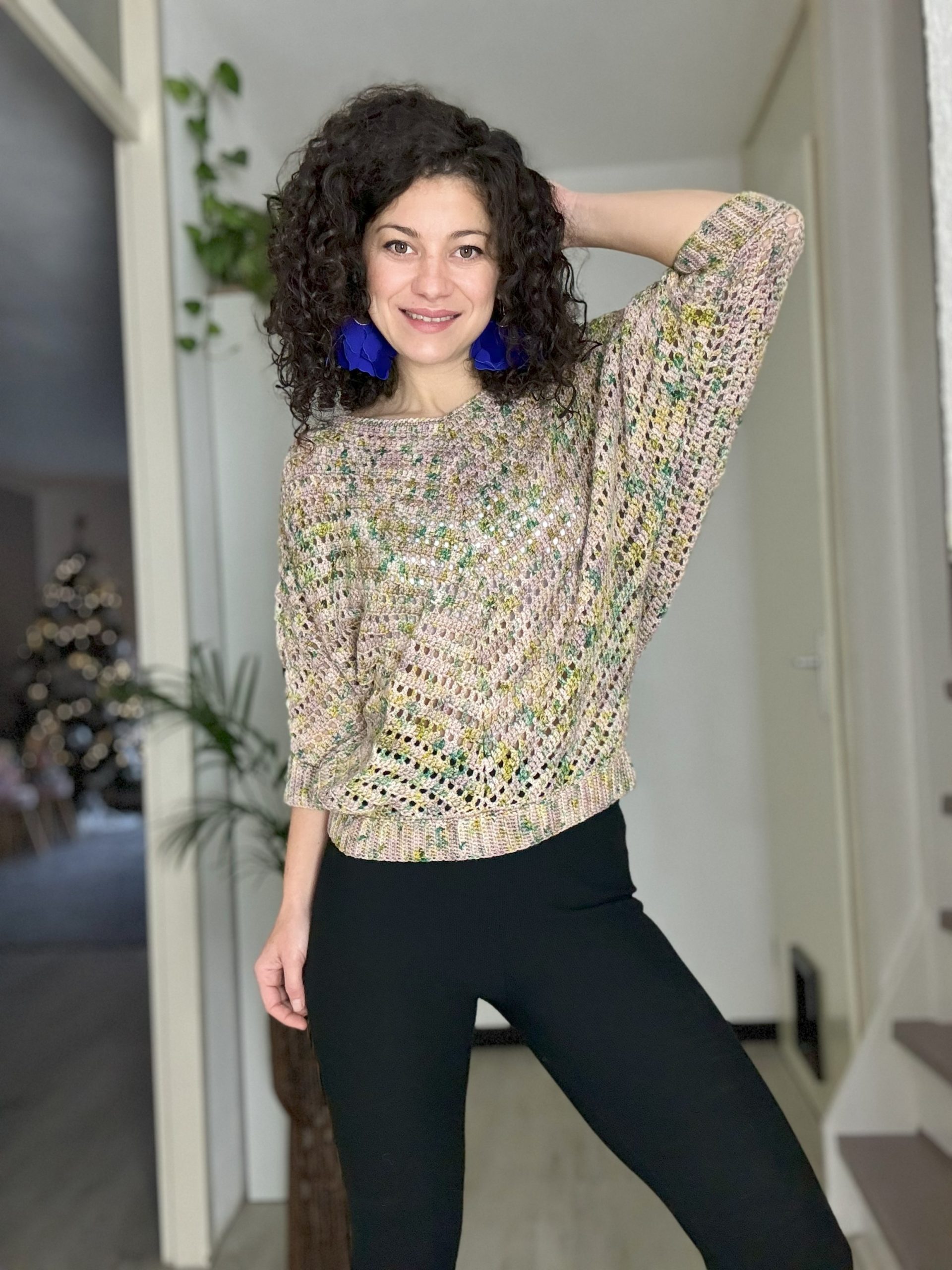
The PDF version of this pattern includes stitch charts. You can purchase the easily printable PDF pattern here:
I hope you will enjoy this new pattern and I can’t wait to see your makes.
MATERIALS
• Yarn: Size 3, Sport) weight yarn
• Crochet Hook:
o 4 mm crochet hook
• stitch markers
• yarn needle for weaving in ends
• Scissors
NOTES ABOUT DESIGN
The Starry Night Blouse is designed with batwing sleeves. It is constructed by working individual panels for the front and back, which are then sewn together.
Each panel consists of four sections that require different techniques to shape the blouse:
Section 1: The main triangle. This section is worked to achieve the desired width from cuff to cuff. As you work on this width, it will also add length to the blouse. It’s important to maintain the proportions while doing so.
Section 2: Creating the armhole or sleeve opening. To achieve this, we decrease stitches at the beginning and end of each row. This helps keep the edges of the armhole straight.
Sections 3 and 4: These sections are worked to make the bottom of the blouse straight and fill the sides of the blouse.
MEASUREMENTS AND SIZES
The Starry Night Blouse pattern is available in 8 sizes, S (M, L, XL) (2XL, 3XL, 4XL, 5XL). In this pattern, you will find information about how to adjust the pattern to your own measurements.

Final Measurements of the Starry Night Blouse
– Cuff to cuff a: 113 cm (120, 127, 127) (133, 147, 153, 160)
– Neck Width b*: 28 cm (28, 28, 28) (28, 28, 28, 28)
– sleeve opening width c: 12 cm (14, 14, 19) (19, 22, 22, 22)
– Bottom hem width d: 43cm (48, 53, 58) (63, 68, 73, 78); measured without stretching
Sleeve length. e: 31 cm (31, 31, 31) (31, 31, 31, 31)
– Length f: 53 cm (57, 60, 66) (68, 73, 75, 77)
*The neck width is measured across the back panel; If you want to adjust it, you have a couple of options mentioned in the pattern

The PDF version of this pattern includes stitch charts. You can purchase the easily printable PDF pattern here:
YARN
For the Starry Night Blouse, I used Palm Breeze by Expression Fiber Arts, in color Buttery; Yarn composition: 100% superwash Merino Wool. Each hank has 100 grams and is approximately 274 meters / 300 yd.
For each size, you will need:
1050 (1190, 1330, 1460) (1580, 1870, 2000, 2150) meters
4 (5, 5, 6) (6, 7, 8, 8) hanks.
ABBREVIATIONS
Ch – chain
Sc – single crochet
Scblo – single crochet in the back loop only
Tsc – twisted single crochet
dc – double crochet
dc2tog – 2 double crochet worked together
dc2tog wide – 2 dc worked together, but skip 1st in between
ss – slip stitch
St(s) – stitch(es)
R – row
TENSION
Using a 4mm crochet hook working in a triangle pattern:
After 6 rows the triangle base measures 20 cm;
17dc = 10 cm
9 rows (alternating 1 solid row with 1 window row) = 10 cm
Note: all the gauge measurements are taken after wet blocking
STITCH PATTERN AND TECHNIQUES
The Starry Night blouse features a stitch pattern that alternates between a solid row and a “windows” row or mesh stitch row. The solid row is worked using double crochet stitches, while the windows row consists of alternating double crochet stitches and chain stitches.
In the description of the Starry Night design, you could see that one panel of the blouse is constructed with three sections:
Section 1: The main triangle. This section has three increases: one at the beginning, one at the middle (also known as the center point), and one at the end of the row. The increases at the beginning and end are achieved by working three stitches in the same stitch. On the solid row, it’s 3 double crochet stitches in the same stitch, and on the windows row, it’s (1 double crochet, 1 chain, 1 double crochet) in the same stitch. The middle row increase is the same in both Section 1 and Section 2: (1 double crochet, 1 chain, 1 double crochet) in the same chain space.
Section 2: In this section, we create the sleeve opening or armhole. To maintain a straight edge for the armhole, we need to decrease at the beginning and end of each row. The rule for decreasing is to reduce the same number of stitches that we added with the middle increase. With the middle increase, we added 2 stitches, one on each side of the triangle. To decrease these stitches at the beginning and end of the row, we use the dc2tog (double crochet two together) stitch. Here’s how to do it: yarn over, insert the hook into the next stitch, yarn over, pull up a loop, yarn over, and pass it through two loops on the hook. Repeat this process once more, then yarn over and pull it through all the loops on your hook. At the beginning of the row, the decrease will be made with 3 chain stitches and 1 double crochet into the next stitch, where the 3 chain stitches do not count as a stitch.
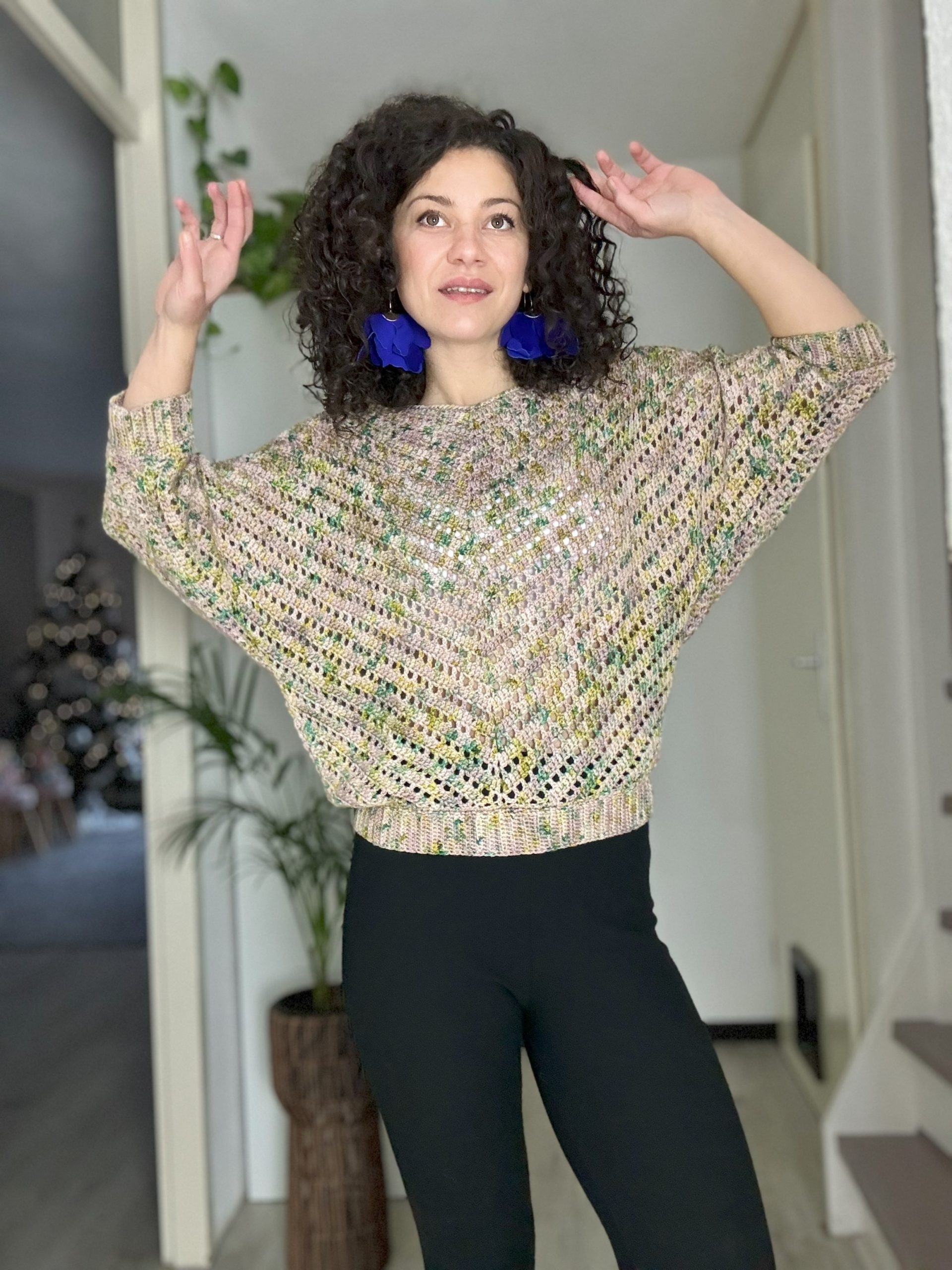
The PDF version of this pattern includes stitch charts. You can purchase the easily printable PDF pattern here:
Sections 3 and 4: These sections are designed to create a straight bottom hem and fill the sides of the panels.
To begin, we need to pick up the desired number of stitches, depending on the width of the bottom hem. Start counting from the middle point towards the left and right sides. Once we have the required number of stitches, we will work exclusively within those stitches for this section. We will decrease at the beginning and end of each row until there are no stitches remaining.
To make the decreases, we will use a wider version of the dc2tog stitch. The process is similar to dc2tog, but with one stitch skipped in between. This allows us to decrease by 2 stitches at each end.
At the beginning of the row, the decrease is made by chaining 3, skipping the next stitch, and then working 1 double crochet in the next stitch. Remember that the initial chain of 3 does not count as a stitch.
HOW TO ADJUST THE STARRY NIGHT BLOUSE PATTERN SO IT CAN FIT YOUR BODY
To ensure a perfect fit for the Starry Night Blouse, it’s important to consider your measurements for cuff to cuff, desired length, armhole opening (upper arm), and bust.
Since the blouse is constructed in panels, we will focus on the width rather than the circumference as a reference.
Let’s break down each part and explain what needs to be done:
Cuff to cuff: This part encompasses the length of the sleeves and the width of the body. In this design, it’s not possible to achieve the full sleeve length right from the start, as increasing the width for cuff to cuff would also add length to the blouse. Therefore, it’s crucial to maintain good proportions.
Step 1: Once you have the desired width for cuff to cuff, you can start working on the main triangle. When the base of the triangle matches the desired measurements, you can proceed to Section 2.
To focus on Section 2, we will concentrate on creating the sleeve opening. To determine the width of the opening, measure your upper arm and divide the measurement by 2. Add an additional 1 to 2 centimeters to ensure the sleeve opening is not too tight.
Step 2: Begin working on Section 2. Once you reach the desired measurements for the sleeve opening, you can proceed to Section 3, followed by Section 4.
Before starting Sections 3 and 4, we need to establish the necessary number of stitches to work with. To do this, we will use the bust width measurements or the widest part of our body as a reference. While this design allows for ample room around the bust, we need to ensure that the bottom hem covers the circumference of the bust to make the blouse easy to wear.
Using a measuring tape, start from the middle point and move upwards, holding the measuring tape perpendicular to the blouse panel. Once you have the desired measurements, considering your bust width, mark those stitches.
Important note: As we work on Sections 3 and 4, the bottom hem will become narrower than our initial measurement. Make sure to add between 10 to 15 centimeters to your bust width measurement. For example, if you started with a desired width of 55 centimeters, the final width of the bottom hem may measure around 43 centimeters.
Make sure you have the same number of sts from middle point to the left and to the right.
Step 3: Begin working on Sections 3 and 4.
PATTERN NOTES
– work the pieces flat; turn after each row;
– ch3 at the end of each row; for Section 1 ch3 will count as a double crochet; for Sections 2, 3, and 4, ch3 will not count as a stitch, it will be part of the decrease
– the follwing pattern includes stitch charts and a video tutorial; the video tutorial is for size small but you can use it as guidance for all the sizes;
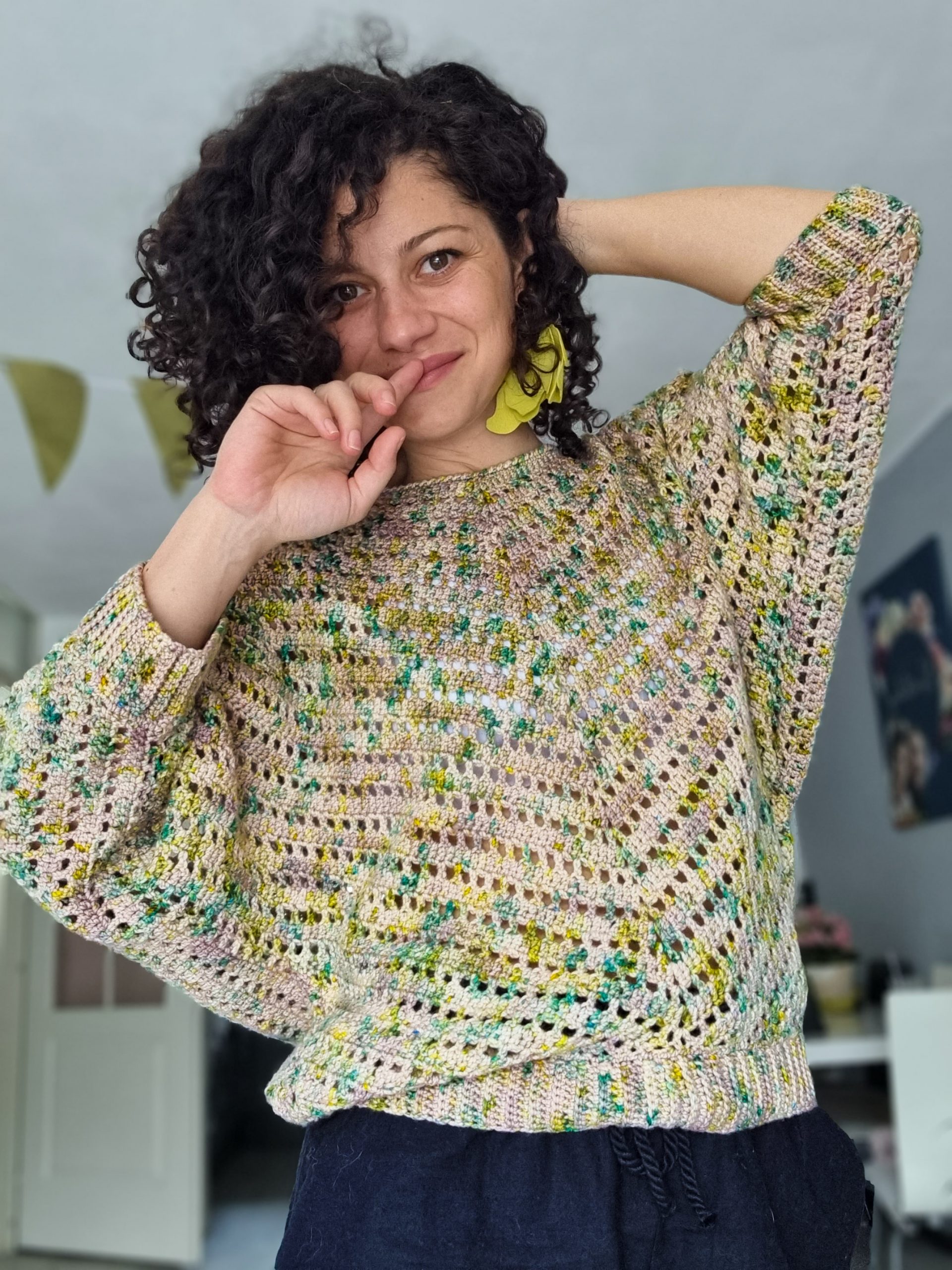
The PDF version of this pattern includes stitch charts. You can purchase the easily printable PDF pattern here:
INSTRUCTIONS
BACK PANEL
Section 1 – Main Triangle
Start: Make a magic ring (or you can ch4 and slip stitch to make a circle)
R1: 3ch, 6dc inside the ring (7sts)
R2:(4ch, 1dc) in the first st, 1ch skip 1st, 1dc in next, 1ch, (1dc, 1ch, 1dc) – center point, into the next st, 1ch, 1dc in next st, 1ch, skip 1 st, (1dc, 1ch, 1dc) into the third ch, 3ch and turn (15 sts)
R3: 2dc in the first st, 1dc in each st until the 1ch-sp center point, (1dc, 1ch, 1dc) into the 1ch-sp, 1dc in each st until the last ch3, 3dc into the third ch; (21 sts)
R4: (ch4, 1dc) into the first st, 1ch, skip the next st, *1dc in next st, 1ch, skip next st; *rep. until the 1ch-sp center point, (1dc, 1ch, 1dc) into the 1ch-sp, 1ch, skip next st, **1dc in next st, 1ch, skip next st; **rep. until the last 3ch, (1dc, 1ch, 1dc) into the third ch; 3ch and turn; (27sts)
Rep. R3 and R4 until you have in total 34 (36, 38, 40) (42, 44, 46, 48) rows.
Note: you will increase 6sts with every row;
At the end of section 1 you should have 207 (219, 231, 243) (255. 267, 279, 291) – counting the 1ch-sp center point as well
If you count from the center point to the left and right you should have 103 (109, 115, 121) (127, 133, 139, 145)
Section 2 – Working accross the armholes
Continue from where your yarn is. We will start counting from R1 as all the sizes are different row numbers to start with.
R1: 3ch, 1dc in next st (3ch will not count as st), 1dc in each st until the 1ch-sp center point (1dc, 1ch, 1dc) into the 1ch-sp, 1dc in each st until you have 2sts left, dc2tog (See the Stitch Pattern and techniques section)
R2: 3ch, 1dc in the next st, 1ch, skip next st, *1dc in next st, 1ch, skip next st; *rep. until the 1ch-sp center point, (1dc, 1ch, 1dc) into the 1ch-sp, 1ch, skip next st, **1dc in next se, 1ch, skip next st; ** rep. until you have 2sts left, dc2tog.
Rep. R1 and R2 until you have in total: 10 (12, 12, 16) (16, 18, 18, 18) rows.
At the end of Section 2 you should have the same number of sts as at the end of Section 1
Section 3 and 4 – make the bottom hem straight and fill the sides of the panel
Both panels are worked the same, only that for Section 3 your last st in the row will be the stitch before the 1ch-sp center point and for Section 4, the stitch after the 1ch-sp center point will be the first st in the row.
Step 1: Establish the number of sts yo work with; this number has to be a multiple of 2+1.
Count from the center point 1ch-sp to the left and right, 55 (61, 67, 73) (81, 87, 93, 99). These sts will be the base for Section 3 and Section 4.
Now that you have the sts you need to start with you can follow the pattern below:
R1: 3ch (this will not count as a st), skip next st, 1dc in next, 1dc in each st until you have 3sts, left, dc2tog wide (See the Stitch Pattern and techniques section.
R2: 3ch, skip next st, *1dc in next, 1ch, skip next st; *rep until you have 3dc left, dc2tog wide;
Rep. R1 and R2 until you have no sts left.
Then Repeat the same pattern for the other side
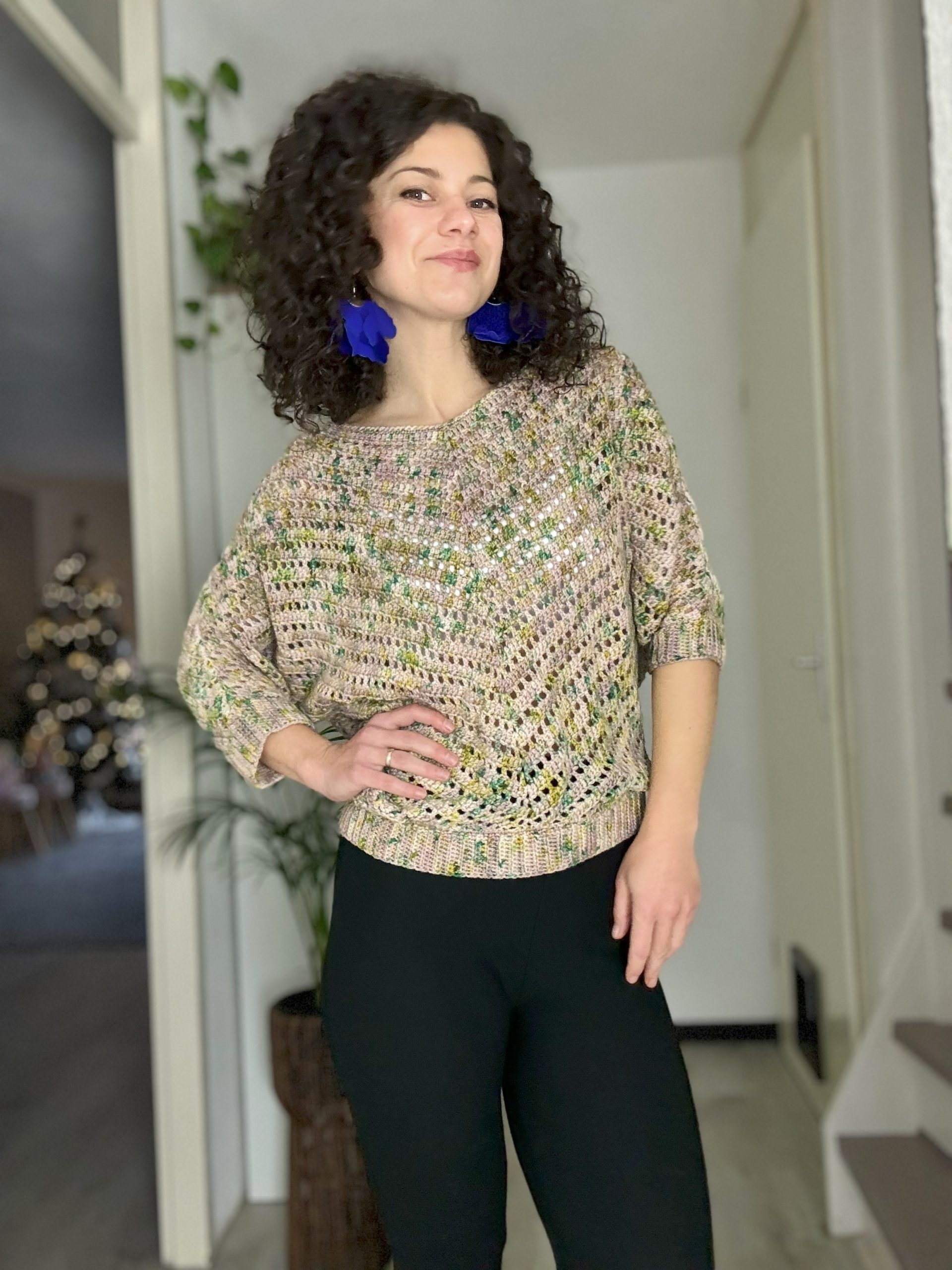
The PDF version of this pattern includes stitch charts. You can purchase the easily printable PDF pattern here:
FRONT PANEL
When working on the front panel of the blouse, you have the flexibility to adjust the width of the neckline.
In this particular pattern, regardless of the size, the front panel begins at Row 11 of the back panel, creating a V-neckline shape.
To modify the neckline width according to the pattern instructions, you have a couple of options:
Starting the front panel with a few rows up: By beginning the front panel at a higher row, you can change the width of the neckline to your preference.
Working both panels without a V-neck: If you prefer not to have a V-neck, you can sew additional stitches for the shoulders. This will allow you to adjust the neckline width accordingly.
Front Panel Section 1
Start: ch64
R1: Start into the 5th st, 2dc, into the 5th st, 1dc in next 29sts, (1dc, 1ch, 1dc) – center point in next st, 1dc in next 29sts, 3dc in last st. (67sts) – this row has the same number of sts as R11 of the back panel.
R2: (4ch, 1dc) in the first st, 1ch skip 1st, 1dc in next, 1ch, (1dc, 1ch, 1dc) – center point, into the next st, 1ch, 1dc in next st, 1ch, skip 1 st, (1dc, 1ch, 1dc) into the third ch, 3ch and turn (73sts)
R3: 2dc in the first st, 1dc in each st until the 1ch-sp center point, (1dc, 1ch, 1dc) into the 1ch-sp, 1dc in each st until the last ch3, 3dc into the third ch; (79 sts)
R4: (ch4, 1dc) into the first st, 1ch, skip the next st, *1dc in next st, 1ch, skip next st; *rep. until the 1ch-sp center point, (1dc, 1ch, 1dc) into the 1ch-sp, 1ch, skip next st, **1dc in next st, 1ch, skip next st; **rep. until the last 3ch, (1dc, 1ch, 1dc) into the third ch; 3ch and turn; (85sts)
Rep. R3 and R4 until you have in total 24 (26, 28, 30) (32, 34, 36, 38) rows.
At the end of section 1 You should have the same number of sts as for the Back Panel.
For section 2, 3 and 4 follow the same pattern as for the BACK PANEL.
ASSEMBLING
Before assembling it is important, depending the yarn you are using to block the panels before sewing. This will prevent the stitches from stretching more than the seam.
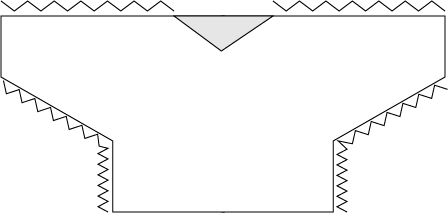
Place the panels one on top of the other, facing the right side.
Stitch first the shoulders and the stitch the sides.
Sewing Method
Prepare the yarn by threading it onto a darning needle, making it about three times longer than the length you are about to sew.
Since we are working with double crochet stitches, we will refer to the stitches as follows:
– Bottom of the double crochet: 1stitch
– Top of the double crochet: 1 stitch
– First chain of the chain-3: 1 stitch
– Last chain of the chain-3: 1 stitch
Step 1: Start by inserting your needle from the back to the front through the first stitch on the right side. Then, bring the needle from the front to the back through the first stitch on the left side. Tie a knot to secure the yarn.
Step 2: Insert the needle into the same stitch on the right side and pull it out through the next stitch on the right side. Then, insert the needle into the same stitch on the left side and pull it out through the next stitch on the left side.
Continue weaving in this manner until you have finished sewing the piece.
EDGING
To prepare the piece for the neckline edging, bottom hem, and sleeves cuff, work first 1 round in single crochet.
When working in to the side rows, consider working 2sc in each dc or ch3 side row; you can adjust the number of sts according with your tension;
Neckline edging
After the first single crochet round, work one more round in a twisted single crochet.
Insert the hook into the next st, yarn over, pull out a loop, twist your hook 180 Degrees clockwise, yarn over, and pass it through both twisted loops. Repeat the process for the entire round.
Bottom hem and cuffs ribbing
Start: rejoin yarn and ch11
R1: start in the second st, 1sc in each of the next 10sts, 1ss into the next 2sts of the bottom hem/sleeves edge; turn
R2: 1scblo in next 10sts, 1ch and turn
R3: 1scblo in each of the next 10sts, 1ss in next 2sts of the bottom hem/sleeves edge; turn
Rep. R2 and R3 until you complete the entire circumference.
Use slip stitch to join the ribbing edges.
TO FINISH
Weave in all the ends and block to measurements.
The PDF version of this pattern includes stitch charts. You can purchase the easily printable PDF pattern here:
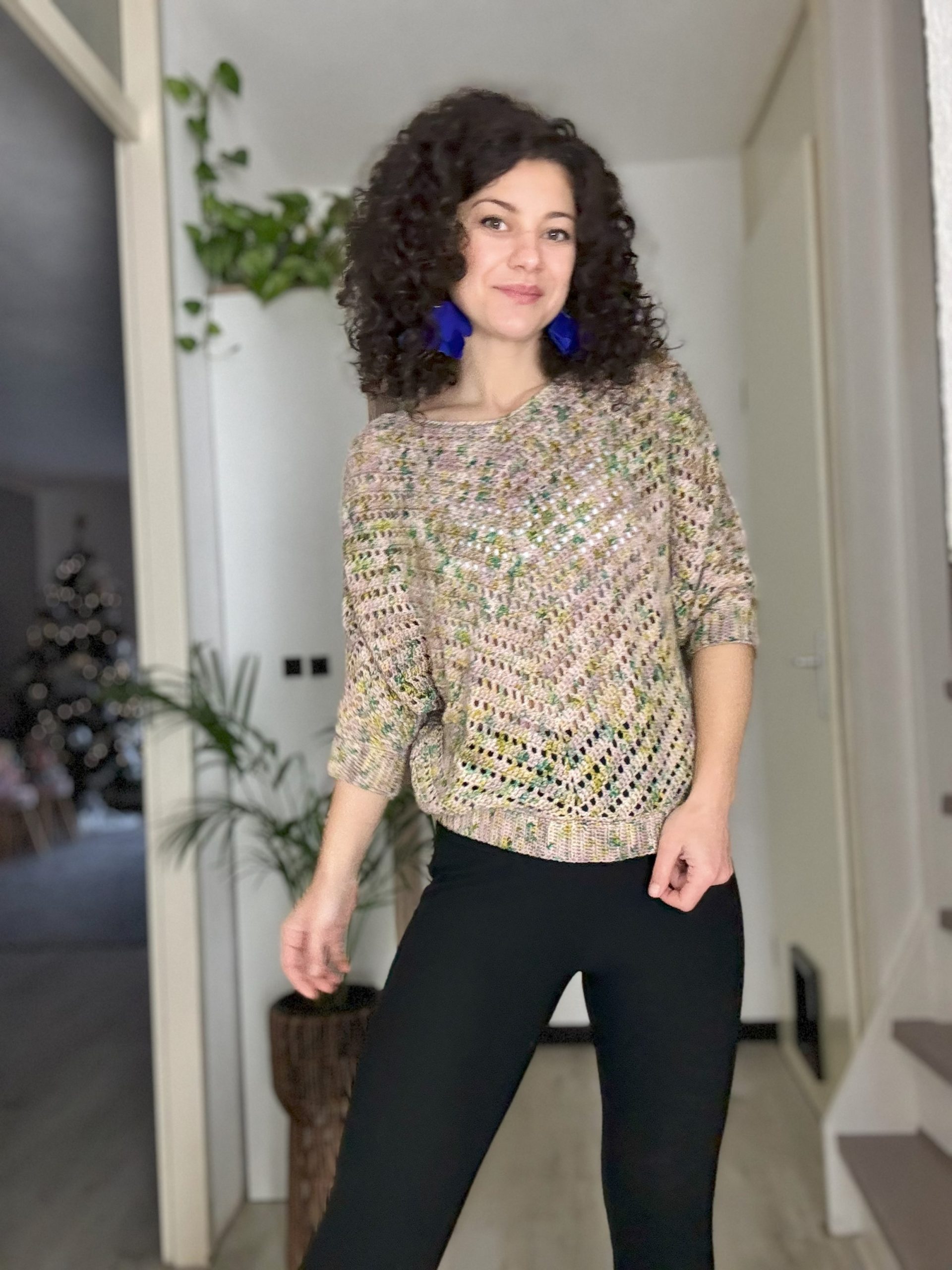

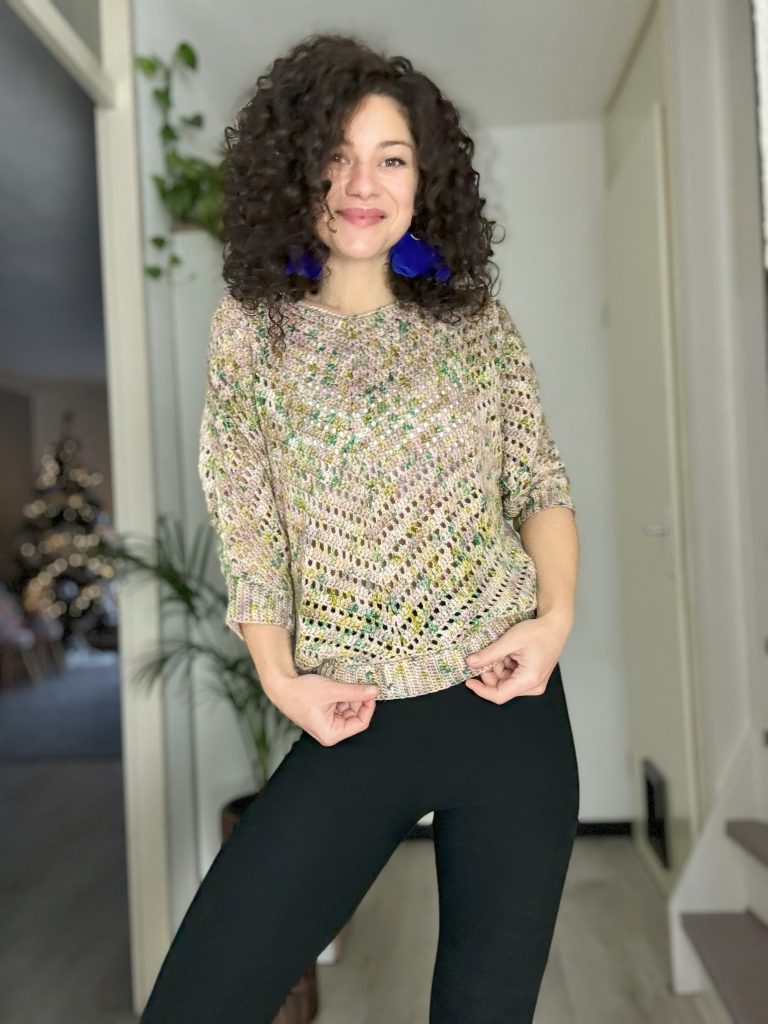


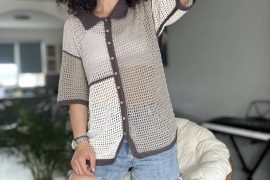
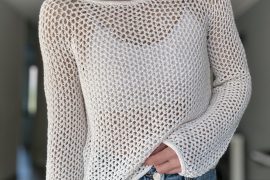
Comments are closed.